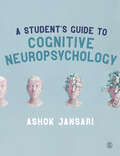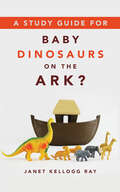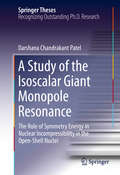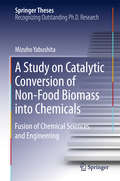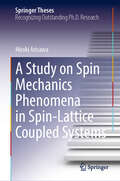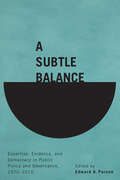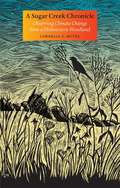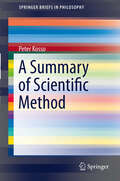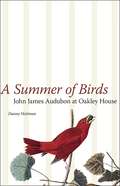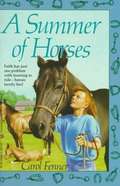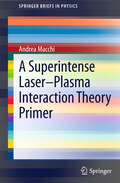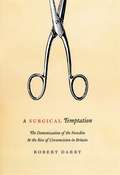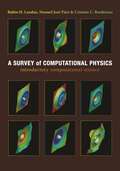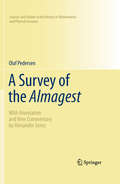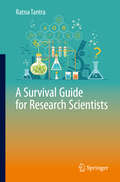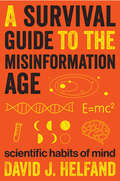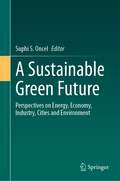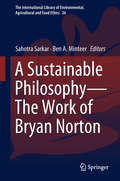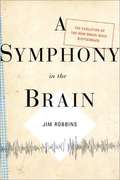- Table View
- List View
A Student′s Guide to Cognitive Neuropsychology
by Ashok JansariAre all brains the same? What causes amnesia? And why did a man mistake his psychologist for George Michael? Find out the answers to these questions, and much more, in A Student′s Guide to Cognitive Neuropsychology. Written in an informative and accessible style, this comprehensive text guides you through the traditional areas of cognitive neuropsychology and beyond, applying core theoretical principles to real-world scenarios. Covering topics from memory to facial recognition, and from language to neglect, this textbook is essential reading for any student of cognitive neuropsychology. A Student′s Guide to Cognitive Neuropsychology also includes features to help enhance your understanding of cognitive neuropsychology, such as: Important researcher spotlights Key research studies Questions for reflection Further reading Ashok Jansari is Senior Lecturer in Cognitive Neuropsychology at Goldsmiths, University of London.
A Student′s Guide to Cognitive Neuropsychology
by Ashok JansariAre all brains the same? What causes amnesia? And why did a man mistake his psychologist for George Michael? Find out the answers to these questions, and much more, in A Student′s Guide to Cognitive Neuropsychology. Written in an informative and accessible style, this comprehensive text guides you through the traditional areas of cognitive neuropsychology and beyond, applying core theoretical principles to real-world scenarios. Covering topics from memory to facial recognition, and from language to neglect, this textbook is essential reading for any student of cognitive neuropsychology. A Student′s Guide to Cognitive Neuropsychology also includes features to help enhance your understanding of cognitive neuropsychology, such as: Important researcher spotlights Key research studies Questions for reflection Further reading Ashok Jansari is Senior Lecturer in Cognitive Neuropsychology at Goldsmiths, University of London.
A Study Guide for BABY DINOSAURS ON THE ARK?
by Janet Kellogg RayIt&’s time to address the elephant in the ark. In Baby Dinosaurs on the Ark? The Bible and Modern Science and the Trouble of Making It All Fit, Janet Kellogg Ray reached out to Christians who experience cognitive dissonance between their creationist commitments and modern science. With this new study guide, she returns to her argument with fresh perspective and an eye toward practical instruction. Ray approaches her topic with empathy for her readers while maintaining scientific rigor. This discussion guide is the perfect companion for students and nonexpert readers of her book, as it includes notes, discussion questions, and lists of external resources to supplement the original. Expanded treatments of each chapter&’s topics encourage thinking with and beyond the concepts introduced in the main text.
A Study of Enzymes, Volume II
by Stephen A. KubyThis comprehensive monograph consists of two parts: Volume I, entitled Enzyme Catalysis, Kinetics, and Substrate Binding; and Volume II, entitled Mechanism of Enzyme Action. Volume I focuses on several aspects of enzyme catalytic behavior, their steady-state and transient-state kinetics, and the thermodynamic properties of substrate binding. Packed with figures, tables, schemes, and photographs, this volume contains over 1,000 references, including references regarding enzymology's fascinating history. This comprehensive book is of particular interest to enzymology students, teachers, and researchers. Volume II presents selected "cutting edge" examples of techniques and approaches being pursued in biochemistry. This up-to-date resource includes 11 chapters, which illustrate important theoretical and practical aspects of enzyme mechanisms. It also features selected examples in which today's most important techniques, ideas, and theories are used to elaborate on the intricate nature of enzyme action mechanisms. This particular volume provides important information for both the novice and the seasoned investigator.
A Study of Enzymes: Enzyme Catalysts, Kinetics, and Substrate Binding (Routledge Revivals #1)
by Stephen A. KubyFirst published in 1990, this comprehensive monograph consists of two parts: Volume I, entitled Enzyme Catalysis, Kinetics, and Substrate Binding; and Volume II, entitled Mechanism of Enzyme Action. Volume I focuses on several aspects of enzyme catalytic behavior, their steady-state and transient-state kinetics, and the thermodynamic properties of substrate binding. Packed with figures, tables, schemes, and photographs, this volume contains over 1,000 references, including references regarding enzymology's fascinating history. This comprehensive book is of particular interest to enzymology students, teachers, and researchers. Volume II presents selected "cutting edge" examples of techniques and approaches being pursued in biochemistry. This up-to-date resource includes 11 chapters, which illustrate important theoretical and practical aspects of enzyme mechanisms. It also features selected examples in which today's most important techniques, ideas, and theories are used to elaborate on the intricate nature of enzyme action mechanisms. This particular volume provides important information for both the novice and the seasoned investigator.
A Study of the Isoscalar Giant Monopole Resonance: The Role of Symmetry Energy in Nuclear Incompressibility in the Open-Shell Nuclei (Springer Theses)
by Darshana Chandrakant PatelThis thesis reports on investigations of a specific collective mode of nuclear vibration, the isoscalar giant monopole resonance (ISGMR), the nuclear "breathing mode", the energy of which is directly related to a fundamental property of nuclei--the nuclear incompressibility. The alpha inelastic scattering experiments reported in this thesis have been critical to answering some fundamental questions about nuclear incompressibility and the symmetry energy, quantities that are crucial to our understanding of a number of phenomena in nuclear physics and astrophysics, including collective excitations in nuclei, radii of neutron stars, and the nature of stellar collapse and supernova explosions. The work described included three sets of experiments and subsequent sophisticated data analysis, both leading to results that have been welcomed by the community and recognised as important contributions to the field.
A Study on Catalytic Conversion of Non-Food Biomass into Chemicals: Fusion of Chemical Sciences and Engineering (Springer Theses)
by Mizuho YabushitaThe topic of this thesis is catalytic conversion ofnon-food, abundant, and renewable biomass such as cellulose and chitin tochemicals. In biorefinery, chemical transformation of polymers to valuablecompounds has attracted worldwide interest for building sustainable societies. First, the current situation of this hot research area has been summarized wellin the general introduction of the thesis, which helps readers to becomefamiliar with this topic. Next, the author explains high-yielding production ofglucose from cellulose by using an alkali-activated carbon as a catalyst,resulting in a yield of glucose as high as 88%, which is one of the highestyields ever reported. The characterization of carbon materials has indicatedthat weak acid sites on the catalyst promote the reaction, which is markedlydifferent from reported catalytic systems that require strong acids. Inaddition, the first catalytic transformation of chitin with retention of N-acetyl groups has been developed. Thecombination of mechanocatalytic hydrolysis and thermal solvolysis enables theproduction of N-acetylated monomers ingood yields of up to 70%. The catalytic systems demonstrated in this thesis areunique in the fields of both chemistry and chemical engineering, and their highefficiencies can contribute to green and sustainable chemistry in the future. Meanwhile, mechanistic studies based on characterization, thermodynamics,kinetics, and model reactions have also been performed to reveal the roles ofcatalysts during the reactions. The results will be helpful for readers todesign and develop new catalysts and reaction systems.
A Study on Spin Mechanics Phenomena in Spin-Lattice Coupled Systems (Springer Theses)
by Hiroki ArisawaThis book presents an experimental investigation of spin-mechanical phenomena in spin-lattice coupled systems. The author demonstrates that the resonant mechanical vibration of a micro magnetic mechanical oscillator changes in response to the magnetization process in the oscillator. The author also investigates a spin-current-induced volume modulation effect in a giant magnetostrictive material. The results presented here accelerate the exploration of cross-correlation effects between spintronics and micromechanics and provide insight into magnetomechanical properties associated with a spin current.
A Subtle Balance: Expertise, Evidence, and Democracy in Public Policy Governance, 1970-2010
by Edward A. ParsonFrom the Asian tsunami of 2004 to hurricane Katrina in 2005 and the Tohoku earthquake of 2011, our century has been fraught with catastrophic natural disasters. Disaster Risk and Vulnerability assesses the human toll and economic losses of natural disasters and reasserts the importance of human collaboration and organization in disaster management. In most cases, policy makers, planners, managers, and regulators who implement disaster risk reduction response planning and management strategies remain detached from local conditions, failing to address them effectively. Presenting case studies from Asia and North America, as well as a broad range of approaches to community mobilization and partnership development, contributors show that local communities, all levels of government, and non-governmental organizations must work collectively in order to reduce the harm caused by disasters. Despite unprecedented progress in science and technology and governments' continued efforts in disaster risk reduction, socioeconomic losses due to environmental disasters continue to rise. Disaster Risk and Vulnerability provides knowledge and information that will benefit anyone working in the fields of environment, disasters, and community mobilization in an effort to reverse this trend.
A Sugar Creek Chronicle: Observing Climate Change from a Midwestern Woodland
by Cornelia F. MutelIn 2010, while editing a report on the effects of climate change in Iowa, ecologist Cornelia Mutel came to grips with the magnitude and urgency of the problem. She already knew the basics: greenhouse gas emissions and global average temperatures are rising on a trajectory that could, within decades, propel us beyond far-reaching, irreversible atmospheric changes; the results could devastate the environment that enables humans to thrive. The more details she learned, the more she felt compelled to address this emerging crisis. The result is this book, an artful weaving together of the science behind rising temperatures, tumultuous weather events, and a lifetime devoted to the natural world. Climate change isn't just about melting Arctic ice and starving polar bears. It's weakening the web of life in our own backyards. Moving between two timelines, Mutel pairs chapters about a single year in her Iowa woodland with chapters about her life as a fledgling and then professional student of nature. Stories of her childhood ramblings in Wisconsin and the solace she found in the Colorado mountains during early adulthood are merged with accounts of global environmental dilemmas that have redefined nature during her lifespan. Interwoven chapters bring us into her woodland home to watch nature's cycles of life during a single year, 2012, when weather records were broken time and time again. Throughout, in a straightforward manner for a concerned general audience, Mutel integrates information about the science of climate change and its dramatic alteration of the planet in ways that clarify its broad reach, profound impact, and seemingly relentless pace. It is not too late, she informs us: we can still prevent the most catastrophic changes. We can preserve a world full of biodiversity, one that supports human lives as well as those of our myriad companions on this planet. In the end, Mutel offers advice about steps we can all take to curb our own carbon emissions and strategies we can suggest to our policy-makers.
A Summary of Scientific Method (SpringerBriefs in Philosophy)
by Peter KossoA Summary of Scientific Method is a brief description of what makes science scientific. It is written in a direct, clear style that is accessible and informative for scientists and science students. It is intended to help science teachers explain how science works, highlighting strengths without ignoring limitations, and to help scientists articulate the process and standards of their work. The book demonstrates that there are several important requirements for being scientific, and the most fundamental of these is maintaining an extensive, interconnected, coherent network of ideas. Some components in the network are empirical, others are theoretical, and they support each other. Clarifying the structure of this web of knowledge explains the role of the commonly cited aspects of scientific method, things like hypotheses, theories, testing, evidence, and the like. A Summary of Scientific Method provides a clear, intuitive, and accurate model of scientific method.
A Summer of Birds: John James Audubon at Oakley House (The Hill Collection: Holdings of the LSU Libraries)
by Danny HeitmanAs the summer of 1821 began, John James Audubon's ambition to create a comprehensive pictorial record of American birds was still largely a dream. Then, out of economic necessity, Audubon came to Oakley Plantation, a sprawling estate in Louisiana's West Feliciana Parish. Teeming with an abundance of birds, the woods of Oakley galvanized Audubon's sense of possibility for one of the most audacious undertakings in the annals of art. In A Summer of Birds, journalist and essayist Danny Heitman sorts through the facts and romance of Audubon's summer at Oakley, a season that clearly shaped the destiny of the world's most famous bird artist. Heitman draws from a rich variety of sources -- including Audubon's own extensive journals, more recent Audubon scholarship, and Robert Penn Warren's poetry -- to create a stimulating excursion across time, linking the historical man Audubon to the present-day civic and cultural icon. He considers the financial straits that led to Audubon's employment at Oakley as a private tutor to fifteen-year-old Eliza Pirrie, Audubon's family history, his flamboyance as a master of self-invention, his naturalist and artistic techniques, and the possible reasons for his dismissal. Illustrations include photographs of Oakley House -- now a state historic site -- Audubon's paintings from his Oakley period, and portraits of the Pirrie family members. A favorable combination of climate and geography made Oakley a birding haven, and Audubon completed or began at least twenty-three bird paintings -- among his finest work -- while staying there. A Summer of Birds will inform and delight readers in its exploration of this eventful but unsung 1821 interlude, a fascinating chapter in the life of America's foremost bird artist. It is an indispensable pleasure for birders, Audubon enthusiasts, and visitors to Oakley House.
A Summer of Horses
by Carol FennerTen-year-old Faith struggles to overcome her fear of horses and her feelings of jealousy toward her talented older sister when they spend the summer on a horse farm.
A Superintense Laser-Plasma Interaction Theory Primer (SpringerBriefs in Physics)
by Andrea MacchiThe continuous trend towards higher and higher laser intensities has opened the way to new physical regimes and advanced applications of laser-plasma interactions, thus stimulating novel connections with ultrafast optics, astrophysics, particle physics, and biomedical applications. This book is primarily oriented towards students and young researchers who need to acquire rapidly a basic knowledge of this active and rapidly changing research field. To this aim, the presentation is focused on a selection of basic models and inspiring examples, and includes topics which emerged recently such as ion acceleration, "relativistic engineering" and radiation friction. The contents are presented in a self-contained way assuming only a basic knowledge of classical electrodynamics, mechanics and relativistic dynamics at the undergraduate (Bachelor) level, without requiring any previous knowledge of plasma physics. Hence, the book may serve in several ways: as a compact textbook for lecture courses, as a short and accessible introduction for the newcomer, as a quick reference for the experienced researcher, and also as an introduction to some nonlinear mathematical methods through examples of their application to laser-plasma modeling.
A Surgical Temptation: The Demonization of the Foreskin and the Rise of Circumcision in Britain
by Robert DarbyIn the eighteenth century, the Western world viewed circumcision as an embarrassing disfigurement peculiar to Jews. A century later, British doctors urged parents to circumcise their sons as a routine precaution against every imaginable sexual dysfunction, from syphilis and phimosis to masturbation and bed-wetting. Thirty years later the procedure again came under hostile scrutiny, culminating in its disappearance during the 1960s. Why Britain adopted a practice it had traditionally abhorred and then abandoned it after only two generations is the subject of A Surgical Temptation. Robert Darby reveals that circumcision has always been related to the question of how to control male sexuality. This study explores the process by which the male genitals, and the foreskin especially, were pathologized, while offering glimpses into the lives of such figures as James Boswell, John Maynard Keynes, and W. H. Auden. Examining the development of knowledge about genital anatomy, concepts of health, sexual morality, the rise of the medical profession, and the nature of disease, Darby shows how these factors transformed attitudes toward the male body and its management and played a vital role in the emergence of modern medicine.
A Survey of Computational Physics: Introductory Computational Science
by Cristian C. Bordeianu José Páez Rubin LandauComputational physics is a rapidly growing subfield of computational science, in large part because computers can solve previously intractable problems or simulate natural processes that do not have analytic solutions. The next step beyond Landau's First Course in Scientific Computing and a follow-up to Landau and Páez's Computational Physics, this text presents a broad survey of key topics in computational physics for advanced undergraduates and beginning graduate students, including new discussions of visualization tools, wavelet analysis, molecular dynamics, and computational fluid dynamics. By treating science, applied mathematics, and computer science together, the book reveals how this knowledge base can be applied to a wider range of real-world problems than computational physics texts normally address. Designed for a one- or two-semester course, A Survey of Computational Physics will also interest anyone who wants a reference on or practical experience in the basics of computational physics. Accessible to advanced undergraduates Real-world problem-solving approach Java codes and applets integrated with text Companion Web site includes videos of lectures
A Survey of Fractal Dimensions of Networks (SpringerBriefs in Computer Science)
by Eric RosenbergMany different fractal dimensions have been proposed for networks. In A Survey of Fractal Dimensions of Networks the theory and computation of the most important of these dimensions are reviewed, including the box counting dimension, the correlation dimension, the mass dimension, the transfinite fractal dimension, the information dimension, the generalized dimensions (which provide a way to describe multifractals), and the sandbox method (for approximating the generalized dimensions). The book describes the use of diameter-based and radius-based boxes, and presents several heuristic methods for box counting, including greedy coloring, random sequential node burning, and a method for computing a lower bound. We also discuss very recent results on resolving ambiguity in the calculation of the information dimension and the generalized dimensions, and on the non-monotonicity of the generalized dimensions. Anyone interested in the theory and application of networks will want to read this Brief. This includes anyone studying, e.g., social networks, telecommunications networks, transportation networks, ecological networks, food chain networks, network models of the brain, or financial networks.
A Survey of the Almagest: With Annotation and New Commentary by Alexander Jones (Sources and Studies in the History of Mathematics and Physical Sciences)
by Alexander Jones Olaf PedersenThe Almagest, by the Greek astronomer and mathematician Ptolemy, is the most important surviving treatise on early mathematical astronomy, offering historians valuable insight into the astronomy and mathematics of the ancient world. Pedersen's 1974 publication, A Survey of the Almagest, is the most recent in a long tradition of companions to the Almagest. Part paraphrase and part commentary, Pedersen's work has earned the universal praise of historians and serves as the definitive introductory text for students interested in studying the Almagest. In this revised edition, Alexander Jones, a distinguished authority on the history of early astronomy, provides supplementary information and commentary to the original text to account for scholarship that has appeared since 1974. This revision also incorporates various corrections to Pedersen's original text that have been identified since its publication. This volume is intended to provide students of the history of astronomy with a self-contained introduction to the Almagest, helping them to understand and appreciate Ptolemy's great and classical work.
A Survival Guide for Research Scientists
by Ratna TantraResearch scientists play a pivotal role in society. Their passion for science will drive them forward, leading to new discoveries that will ultimately make the world a better place. Unfortunately, as the professional environment becomes more and more competitive, research scientists today cannot just rely on technical knowledge to carve successful careers. Besides technical skills, they will need to acquire other skills, such as how to communicate their science to the outside world. A Survival Guide for Research Scientists is a one-stop-shop that will help you to develop those core skills not often taught at school or university. The book has been written by an author with more than 20 years of scientific research experience (across different scientific disciplines). She has not only been a research scientist but also a writer, a consultant, a sole-trader and a project manager. A Survival Guide for Research Scientists takes on a holistic approach in order to help you pave the way for success. As such, it features practical guidelines on how to: • conduct your scientific research (how to: do literature review, design experiments, adopt best practice, ensure health and safety, etc.).• write and edit (reports, bid proposals, peer review publications, etc).• interact with the outside world (be a team leader, manage a project, network, deal with difficult people, do presentations, organise meetings, etc.).• look after your career (and get your dream job). • look after yourself (and how to manage stress). • look for a job (develop your CV, prepare for interviews, etc.). • become self-employed (and achieve business success). • deal with redundancy (and move forward in life, etc) Whatever your scientific background may be, this book is the perfect accompaniment, to guide you at every stage of your career.
A Survival Guide to the Misinformation Age: Scientific Habits of Mind
by David HelfandWe live in the Information Age, with billions of bytes of data just two swipes away. Yet how much of this is mis- or even disinformation? A lot of it is, and your search engine can't tell the difference. As a result, an avalanche of misinformation threatens to overwhelm the discourse we so desperately need to address complex social problems such as climate change, the food and water crises, biodiversity collapse, and emerging threats to public health. This book provides an inoculation against the misinformation epidemic by cultivating scientific habits of mind. Anyone can do it—indeed, everyone must do it if our species is to survive on this crowded and finite planet.This survival guide supplies an essential set of apps for the prefrontal cortex while making science both accessible and entertaining. It will dissolve your fear of numbers, demystify graphs, and elucidate the key concepts of probability, all while celebrating the precise use of language and logic. David Helfand, one of our nation's leading astronomers and science educators, has taught scientific habits of mind to generations in the classroom, where he continues to wage a provocative battle against sloppy thinking and the encroachment of misinformation.
A Survival Guide to the Misinformation Age: Scientific Habits of Mind
by David J. HelfandLearning how to tell news from fake news from fake fake news: An &“important and timely&” book on protecting ourselves, and society, from the infodemic (Library Journal). We have billions of bytes of data at our fingertips. But how much of it is misinformation—or even disinformation? A lot of it is, and your search engine can&’t tell the difference. As a result, an avalanche of misinformation threatens to overwhelm the discourse we so desperately need to address complex social problems such as climate change, the food and water crises, biodiversity collapse, and emerging threats to public health. This book provides an inoculation against the misinformation epidemic by cultivating scientific habits of mind. Anyone can do it—indeed, everyone must do it if our species is to survive on this crowded and finite planet. This survival guide supplies an essential set of apps for the prefrontal cortex while making science both accessible and entertaining. It will dissolve your fear of numbers, demystify graphs, and elucidate the key concepts of probability, all while celebrating the precise use of language and logic. David Helfand, one of our nation&’s leading astronomers and science educators, has taught scientific habits of mind to generations in the classroom, where he continues to wage a provocative battle against sloppy thinking and the encroachment of misinformation. &“Provides a vital antidote to the ills of misinformation by teaching systematic and rigorous scientific reasoning.&” —The Times Literary Supplement
A Sustainable Bioeconomy: The Green Industrial Revolution
by Mika Sillanpää Chaker NcibiAn authoritative and comprehensive volume of knowledge and green technologies wholly focused on the future of the bioeconomy. The authors present data, show opportunities, discuss R&D findings, analyze strategies, assess the wider economic impact, showcase achievements, criticize policies and propose solutions for the green revolution in biofuels, biochemicals and biomaterials' production and power generation. A fascinating range of case studies from the US, China and many European countries are used to inform readers about the impact of this field on society and how various technologies are currently being implemented. Additionally, the role of industry on this green industrial revolution is outlined with contributions from several major companies such as DuPont (US), UPM-Kymmene Oy (Finland), Anhui BBCA Biochemical Co (China).
A Sustainable Green Future: Perspectives on Energy, Economy, Industry, Cities and Environment
by Suphi S. OncelThe aim of this book is to open a vision to sustainability and development through a holistic perspective comprising the critical blocks of energy, environment and economy. From renewable energy, urban infrastructure, societal health to industrial symbiosis, the book assesses critical issues to reach a green future with realistic solutions proposed by a diverse range of multidisciplinary experts. It is intended for a broad readership of academics, researchers and industry experts focusing on these fields, and with specializations in sustainability. The book is divided into different clusters starting with an introductory foreword to express the theme of the book and the route of the titles. The first cluster of the book highlights various multidisciplinary perspectives considering the interaction between different expertise. From engineering to economy supported with social pillars, this section gives the critical points of selected topics to focus on the future with a sustainability vision. The second cluster focuses on health issues, with discussion about the impacts of the COVID-19 pandemic and the way forward. Critical points like vaccines, health care and food security are highlighted. The third cluster is comprised of titles related to the urban environment and infrastructure. New solutions and discussions on biodesign, waste management and transportation are covered in this section. The last cluster covers energy, and highlights renewable energies such as bioethanol, biogas and wind.
A Sustainable Philosophy—The Work of Bryan Norton (The International Library of Environmental, Agricultural and Food Ethics #26)
by Ben A. Minteer Sahotra SarkarThis book provides a richly interdisciplinary assessment of the thought and work of Bryan Norton, one of most innovative and influential environmental philosophers of the past thirty years. In landmark works such as Toward Unity Among Environmentalists and Sustainability: A Philosophy of Adaptive Ecosystem Management, Norton charted a new and highly productive course for an applied environmental philosophy, one fully engaged with the natural and social sciences as well as the management professions. A Sustainable Philosophy gathers together a distinguished group of scholars and professionals from a wide array of fields (including environmental philosophy, natural resource management, environmental economics, law, and public policy) to engage Norton’s work and its legacy for our shared environmental future. A study in the power of intellectual legacy and the real-world influence of philosophy, the book will be of great interest scholars and students in environmental philosophy, public policy and management, and environmental and sustainability studies. By considering the value and impact of Norton’s body of work it will also chart a course for the next generation of pragmatic environmental philosophers and sustainability scholars grappling with questions of environmental value, knowledge, and practice in a rapidly changing world.
A Symphony in the Brain: The Evolution of the New Brain Wave Biofeedback
by Jim RobbinsRobbins traces the fascinating, untold story of the development of neurofeedback, including its discovery by a small corps of research scientists, its growing applications around the world, the contentious history in the 1970s, and present battles for acceptance in the medical community.
